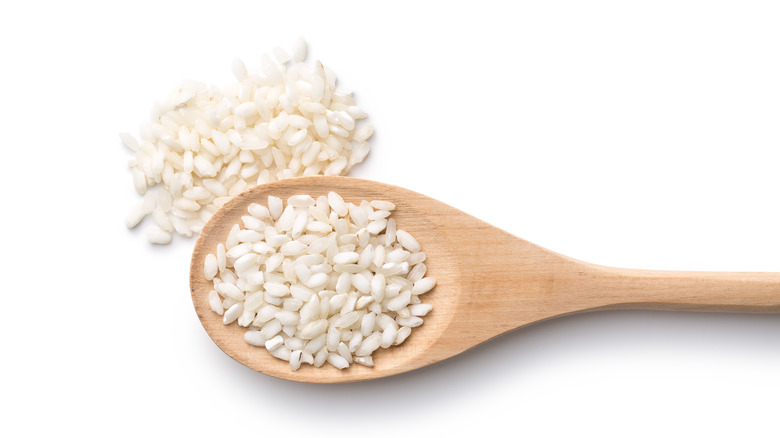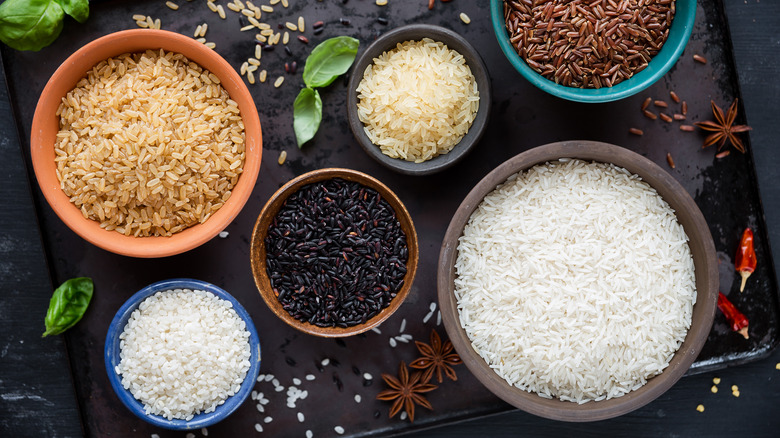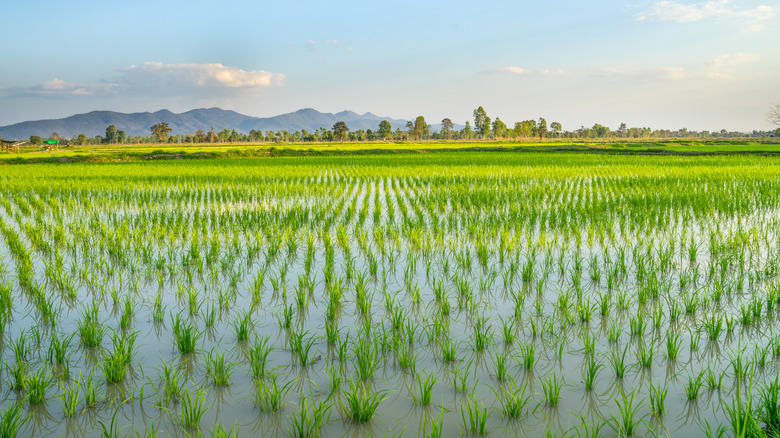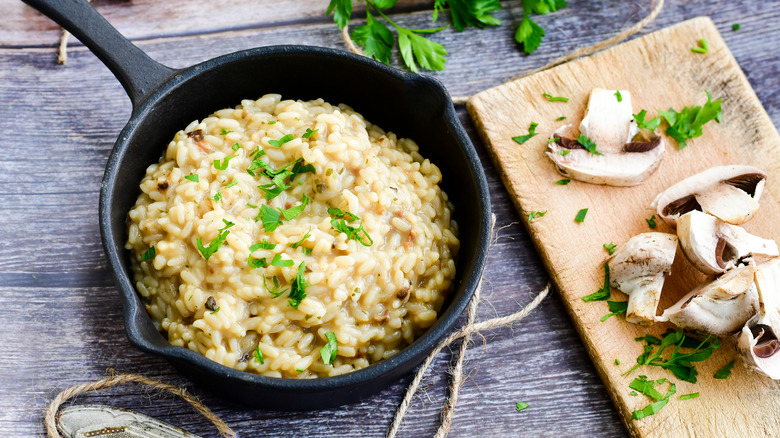What Is Arborio Rice And How Do You Use It?
Rice is one of the most popular grains on earth, consumed in just about every single part of the world, according to Statista. In China alone, the site notes, residents ate 149 million metric tons this past year and total global consumption was roughly 496 million metric tons. Now that's a lot of rice!
The popularity of the grain stems from the affordability, convenience, filling, and comforting nature of it, says The Guardian. The fact that rice is so widely eaten just furthers the love. It helps, too, that there is such a wide variety of rice to enjoy in a number of dishes.
Statista says the most popular rice choices across the globe include indica, japonica, and aromatic. But there is one in particular you may not know much about, arborio rice. If you are trying to figure out what that is, just think of the classic Italian dish risotto and you'll have an idea of what this short-grain wonder can do.
What exactly is arborio rice?
Although it's smaller in size than regular white rice, arborio is still considered large within its rice species, Oryza sativa japonica. It originated in the same-named area of Italy, according to Master Class, but has since made its way to the US and is grown in California and Texas. Just like any other kind of rice, it is a grain — but a bit shorter than the others. Unlike long and thin rice, arborio is short, round, and oval-shaped, according to The Spruce Eats.
Unlike regular rice that is usually made as a side dish or a base for other foods like stir fry, arborio is best known for its creamy soup-like texture and shines in dishes like the aforementioned risotto as well as rice pudding. That's because it goes through less milling than long-grain rice, and has more of the starchy compound amylopectin (via The Spruce Eats). Starch is released in the cooking process, which is what makes arborio so much chewier and creamier.
How is arborio rice made?
Great Italian Chefs says that most Italian rice is produced in Vercelli. Although it can be grown in the US, this village town is where most European rice is made — and even 90% of the sushi rice eaten in all of Europe! While rice may seem like a simple thing to plant, it's actually far more complicated than people might realize.
Rice crops are unique, with all of them having to be flooded with water for months at a time. Each crop has a special system of canals and pipes to ensure the water flows out when needed (via Great Italian Chefs). Rice is first planted in March and not harvested until September. That is a whole seven months of waiting just for tiny pieces of grain to be ready to gather.
The rice is kept in 6-8 inches of water at a time. Eventually, the water will evaporate and it'll become time to harvest the grains. After it's harvested, rice is then dried and prepped for the milling processes, says Cross Currents. So, the next time you throw away some leftover rice, remember that it takes over half-a-year to make!
How to cook arborio rice
Cooking arborio rice is pretty similar to how you'd cook most other kinds of rice — and the mistakes that can come with it. For example, if you accidentally over-cook Minute Rice and end up with a mushy mess, the same thing can happen to arborio if you're not careful, says The Kitchn.
There are multiple ways to cook arborio rice, according to The Forked Spoon. The most common ways are stovetop, instant pot, and microwave. For stovetop, simply add water or a stock of your choice to a sauce pan and bring it to a simmer. Let the water or stock stay warm and keep it to the side. If you want to add veggies to the rice, sauté them separately in another pan with some seasonings.
Lightly cook the rice in the skillet with butter and the veggies (mushrooms are a great pick for risotto). Remember, the ratio is 1:4, so you'll want to add 1 cup of rice for every 4 cups of water (via The Forked Spoon). Ladle in about a cup of the simmering water at a time, and let the rice absorb it. Once absorbed, ladle in the rest slowly. This process will take about 20-30 minutes, but to ensure the arborio stays firm and creamy, patience is key.
For the instant pot method, set the pot to the sauté function and then once you have toasted your rice in the pot with butter and whichever veggies you'd like, do the same technique of adding the simmering water/broth until absorbed. Only this time, you can simply add in all of the liquid and set the instant pot to manual and cook on high for five minutes (via Delish).
The fastest way is, of course, dorm-room style with your microwave. To cook arborio this way, first heat up veggies and butter in a dish, and then microwave the water or stock until it's hot. Finally, combine all ingredients, including the arborio, in one dish and cook on high for six minutes, according to All Recipes.
The nutrition and benefits of eating arborio rice
Arborio rice is very similar to its cousins in the rice family when it comes to nutritional values. It is a carb and therefore carries 90% of its calories from carbohydrates (via The Spruce Eats). One serving contains 4 grams of protein and is a good source of fiber as well. There is only about half a gram of fat in this portion size.
LiveStrong notes there are 170 calories per quarter-cup, uncooked, which should be plenty for a meal. The article adds that arborio is not a rich source of vitamins or minerals that may benefit your daily diet. The grain does, however, have a small amount of iron. A quarter-cup will provide 1% of the daily recommended intake of iron.
But, remember you can still enjoy arborio and serve it alongside meat and/or veggies that can add vitamins and minerals that may be lacking in the grain. The other great thing about arborio rice is that, like its counterparts, it's gluten-free.




